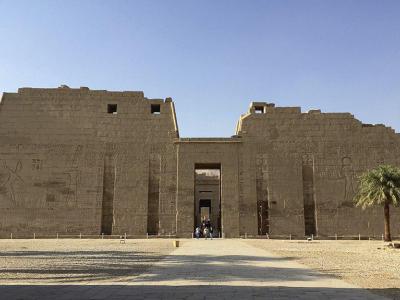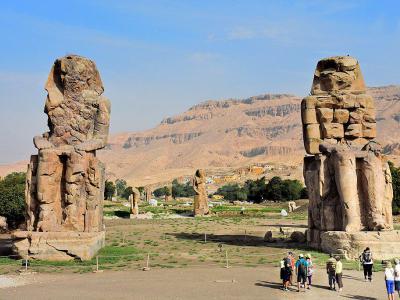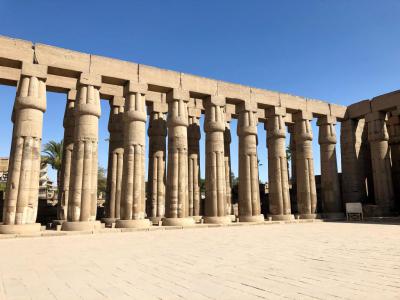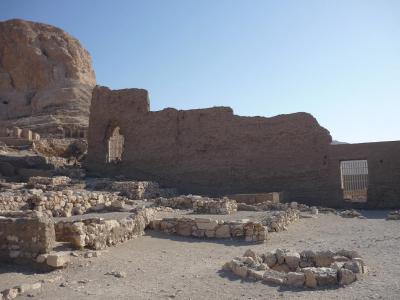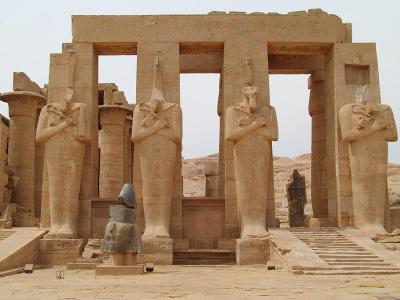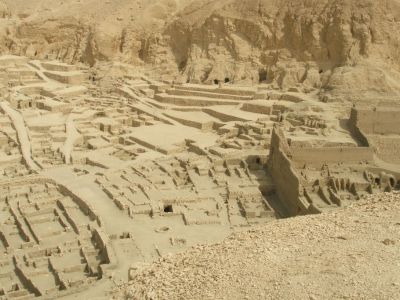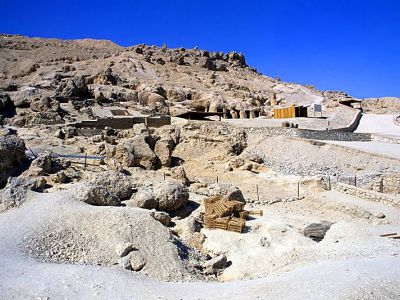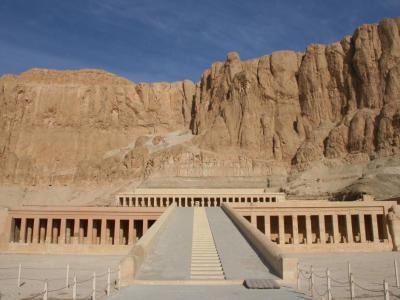Luxor Archaeology Tour Part 1 (Self Guided), Luxor
The Theban necropolis area - located in Upper Egypt, across the River Nile from the modern city of Luxor - is considered to be one of the most significant archaeological sites in the world. You will be amazed by the many splendid temples, tombs and other historic attractions in this area, which is now known as Luxor's West Bank. The ruins of the Workers Village, the Colossi of Memnon, and many other unique archaeological wonders can be visited here on our walking tour.
How it works: Download the app "GPSmyCity: Walks in 1K+ Cities" from Apple App Store or Google Play Store to your mobile phone or tablet. The app turns your mobile device into a personal tour guide and its built-in GPS navigation functions guide you from one tour stop to next. The app works offline, so no data plan is needed when traveling abroad.
Luxor Archaeology Tour Part 1 Map
Guide Name: Luxor Archaeology Tour Part 1
Guide Location: Egypt » Luxor (See other walking tours in Luxor)
Guide Type: Self-guided Walking Tour (Sightseeing)
# of Attractions: 8
Tour Duration: 3 Hour(s)
Travel Distance: 6.5 Km or 4 Miles
Author: ashley
Sight(s) Featured in This Guide:
Guide Location: Egypt » Luxor (See other walking tours in Luxor)
Guide Type: Self-guided Walking Tour (Sightseeing)
# of Attractions: 8
Tour Duration: 3 Hour(s)
Travel Distance: 6.5 Km or 4 Miles
Author: ashley
Sight(s) Featured in This Guide:
- Medinet Habu
- Colossi of Memnon
- Temple of Amenhotep III
- Deir El Madina
- Ramesseum
- Tombs of the Nobles
- Dra' Abu el-Naga' Necropolis
- Hatshepsut's Temple
1) Medinet Habu (must see)
Medinet Habu is a vast complex that includes the mortuary temple of Ramses III and is second only to the Karnak Temples in size. From ancient times the site was considered holy to the Egyptians as it was believed that this was the place where the god Amun appeared for the first time. The pharaohs of the New Kingdom were buried in the Valley of the Kings, but built large temples as centers for their worship as gods following their deaths. Excavations on the site began in 1859 and continue to this day uncovering ever more fascinating relics and understanding of the past.
There are many different constructions and temples in the complex that were used as storehouses, priests’ residences, workshops and even it is thought, the Ramses III harem. The best preserved of the buildings at the complex is the Ramses III mortuary temple. Although traditional in many aspects of its architectural design, it features a unique entrance, which is thought to have been modeled after citadels the pharaoh visited on campaigns in Syria. The temple is also home to some impressive and well preserved reliefs showing Ramses III defeating his enemies, including the Libyans and Asians. These immense friezes show the many invasions that Ramses III was subjected to during his long reign.
There are many different constructions and temples in the complex that were used as storehouses, priests’ residences, workshops and even it is thought, the Ramses III harem. The best preserved of the buildings at the complex is the Ramses III mortuary temple. Although traditional in many aspects of its architectural design, it features a unique entrance, which is thought to have been modeled after citadels the pharaoh visited on campaigns in Syria. The temple is also home to some impressive and well preserved reliefs showing Ramses III defeating his enemies, including the Libyans and Asians. These immense friezes show the many invasions that Ramses III was subjected to during his long reign.
2) Colossi of Memnon (must see)
The Colossi of Memnon are two giant stone statues located in the Necropolis of Thebes, near the city of Luxor. The immense statues have been dated to around 1350 B.C and are likenesses of Pharaoh Amenhotep III. The 18 meter twin sculptures show the pharaoh seated with his hands in his lap looking out over the Nile River. Carved beside his legs are two smaller images of his mother, Mutemwiya and his wife, Tiye. At the side of the colossi are carved impressions of the Nile god, Hapy. Originally the statues lay at the entrance to Amenhotep’s mortuary temple around which a hugely popular cult worshipped the pharaoh as a living god. Unfortunately, little remains of the opulent temple complex due to flooding of the Nile undermining the foundations and inundating the constructions over the millennia.
The colossi themselves have taken a beating over time, but they are still very impressive constructions. Made from quartzite sandstone, it is thought that the stone was quarried 675 km away at el-Gabal el-Ahmar and transported by land as the stone would have been too heavy to be sent down the river. The Greek geographer Strabo wrote in the first century A.D about an earthquake damaging the northern colossus and that following this event, the statue began to sing at dawn. Hearing the statue singing, most likely caused evaporation of dew, is said to be lucky and bring oracular powers. This feature attracted many Roman emperors to visit the colossi.
The colossi themselves have taken a beating over time, but they are still very impressive constructions. Made from quartzite sandstone, it is thought that the stone was quarried 675 km away at el-Gabal el-Ahmar and transported by land as the stone would have been too heavy to be sent down the river. The Greek geographer Strabo wrote in the first century A.D about an earthquake damaging the northern colossus and that following this event, the statue began to sing at dawn. Hearing the statue singing, most likely caused evaporation of dew, is said to be lucky and bring oracular powers. This feature attracted many Roman emperors to visit the colossi.
3) Temple of Amenhotep III
The Temple of Amenhotep III was the largest and most opulent in Egypt in its heyday. Originally around 35 hectares in size it stretches back from the Colossi of Memnon back to the Antiquities Inspectorate. The Temple of Amenhotep III was the site of a huge cult honoring the pharaoh and worshipping him as a living god. Unfortunately, the land that the temple was built on was prone to flooding from the Nile River and this caused its rapid decay. It is thought that the flooding of the Nile was used as an engineering tool to cause the inundation of the eastern courts of the site at certain times of the year to spectacular effect.
Until recently, all that remained of the vast mortuary temple were the colossi – a giant pair of statues that served as the entrance. Excavations of the site have now revealed the pillars and general lay out of the site. Archaeologists have now uncovered several halls and constructions that are being excavated. These projects have also revealed invaluable artifacts such as a headless sphinx statue of Queen Tiye, Amenhotep’s wife, jackal statues and Osirid statues of the pharaoh. Around the base of many of the discovered statues is information about battles and captives that has provided important information about the reign of Amenhotep III.
Until recently, all that remained of the vast mortuary temple were the colossi – a giant pair of statues that served as the entrance. Excavations of the site have now revealed the pillars and general lay out of the site. Archaeologists have now uncovered several halls and constructions that are being excavated. These projects have also revealed invaluable artifacts such as a headless sphinx statue of Queen Tiye, Amenhotep’s wife, jackal statues and Osirid statues of the pharaoh. Around the base of many of the discovered statues is information about battles and captives that has provided important information about the reign of Amenhotep III.
4) Deir El Madina (must see)
Deir El Medina is a UNESCO World Heritage Site that served as a village for the artisans and builders who worked in the Valley of the Kings between 1550 and 1080 B.C. The village was laid out around an amphitheater and is thought to have been built separately to the general population in order to better preserve the secrecy of the constructions in the Valley of the Kings. Excavation of the many houses and tombs on the site began in the early 20th century and today you can see some astonishing artifacts and buildings that have been uncovered.
The village necropolis features some delightful pyramids and tombs where architects and other important artisans were buried. One of the highlights of the site is the Tomb of Sennedjem, which is a stunning tomb in excellent condition where a servant of the 18th dynasty was buried. The highly decorative painted walls show many scenes from the servant’s personal life alongside his wife and family. The recently opened Tomb of Pashedu is well known for its colourful wall decorations, featuring friezes from everyday life. Another gem is the Tomb of Inherkhau, which belongs to a well-known foreman in the Valley of the Kings, and renowned for its colourful reliefs. For a glimpse into the lives of the common people of antiquity, Deir El Medina is a fascinating place to visit.
The village necropolis features some delightful pyramids and tombs where architects and other important artisans were buried. One of the highlights of the site is the Tomb of Sennedjem, which is a stunning tomb in excellent condition where a servant of the 18th dynasty was buried. The highly decorative painted walls show many scenes from the servant’s personal life alongside his wife and family. The recently opened Tomb of Pashedu is well known for its colourful wall decorations, featuring friezes from everyday life. Another gem is the Tomb of Inherkhau, which belongs to a well-known foreman in the Valley of the Kings, and renowned for its colourful reliefs. For a glimpse into the lives of the common people of antiquity, Deir El Medina is a fascinating place to visit.
5) Ramesseum (must see)
The Ramesseum was the mortuary temple for Ramses II, one of the best known and longest ruling pharaohs of ancient Egypt. The reign of Ramses II was marked by the construction of many of the 18th dynasty’s finest buildings and monuments, and the Ramesseum was one of its greatest architectural feats. Known in its time as the “Million Years Temple”, perhaps in recognition of its immense size, the temple took 20 years to build. Originally there were two colossal statues of Ramses II at the entrance to the temple, these have since collapsed, but you can see parts of them throughout the complex.
The temple was designed around two supporting walls with an extensive corridor between them, where statues of sphinxes, similar to those found at the Luxor Temple, were present. There are also impressive Oriside columns, which feature Ramses II transforming into Osiris, god of the underworld. These columns are in an excellent condition and still feature much of the original coloring and detail, depicting scenes from the Upper and Lower Kingdoms of Ancient Egypt. At the eastern end of the Ramesseum there are scenes of the pharaoh’s alliance with the Hittites, one of his major achievements in Asia over a 15 year period. Friezes on the entrance pylon clearly show the Ramses II army on the move during military campaigns.
The temple was designed around two supporting walls with an extensive corridor between them, where statues of sphinxes, similar to those found at the Luxor Temple, were present. There are also impressive Oriside columns, which feature Ramses II transforming into Osiris, god of the underworld. These columns are in an excellent condition and still feature much of the original coloring and detail, depicting scenes from the Upper and Lower Kingdoms of Ancient Egypt. At the eastern end of the Ramesseum there are scenes of the pharaoh’s alliance with the Hittites, one of his major achievements in Asia over a 15 year period. Friezes on the entrance pylon clearly show the Ramses II army on the move during military campaigns.
6) Tombs of the Nobles (must see)
Out of the many hundreds of nobles’ tombs that have been identified and uncovered at the Theban Necropolis, there are six that are a must visit. The excavated tombs span a period of around 500 years during the New Kingdom and are the final resting place of courtesans and nobles of Ancient Egypt. The Tombs of the Nobles offers a different perspective to the many pharaoh temples and tombs in the region with the emphasis of murals being more on travelling from earth to the afterlife and scenes from the everyday life of those buried here. There are few carved reliefs on the walls here, as compared to other locations around Luxor, which is largely to do with the soft limestone found at the site. Instead, you find brightly painted murals.
The Tomb of Rekhmire, a governmental vizier provides important historical information relating to the reigns of Thuthmoses III and Amenophis II and foreign policy. The colorful Tomb of Sennofer depicts the life of the Mayor of Thebes in 1550 B.C, and is often known as the “Tomb of Vines” for all the grape vines found painted on the walls. The Tomb of Ramose is fascinating as the vizier and governor of the 14th Century B.C lived at the time of Akenhaten, when massive religious changes occurred in the kingdom. Other important tombs to visit at the site include those of Userhat and Khaemhat, who were royal scribes, and Nakht, a royal astronomer.
The Tomb of Rekhmire, a governmental vizier provides important historical information relating to the reigns of Thuthmoses III and Amenophis II and foreign policy. The colorful Tomb of Sennofer depicts the life of the Mayor of Thebes in 1550 B.C, and is often known as the “Tomb of Vines” for all the grape vines found painted on the walls. The Tomb of Ramose is fascinating as the vizier and governor of the 14th Century B.C lived at the time of Akenhaten, when massive religious changes occurred in the kingdom. Other important tombs to visit at the site include those of Userhat and Khaemhat, who were royal scribes, and Nakht, a royal astronomer.
7) Dra' Abu el-Naga' Necropolis
On the western bank of the Nile at Luxor lies the Dra' Abu el-Naga' Necropolis, one of the longest operating cemeteries in ancient Egypt. The oldest burial at the site has been dated to around 2000 B.C during the Middle Kingdom and it was used continuously up until early Coptic Christian times around 2500 years later. The necropolis is remarkable for the range of social status to be found at the site from humble burials to tombs of high ranking officials and even some kings and queens of the 17th and 18th dynasties.
The popularity of the site is linked to the location of the necropolis just across from the Temple of Karnak. This was the main religious center for the worship of Amun and one of the most important temples during the New Kingdom. Also within the necropolis are the remains of a large Coptic monastery that was inhabited between the 5th and 8th Centuries A.D. Excavations continue at the site and new discoveries have included a tomb belonging to Amun-Em-Opet, supervisor of the hunters just prior to the reign of Akhenaten and entrances to two undecorated tombs and seals bearing the names of a royal messenger and supervisor of the palace.
The popularity of the site is linked to the location of the necropolis just across from the Temple of Karnak. This was the main religious center for the worship of Amun and one of the most important temples during the New Kingdom. Also within the necropolis are the remains of a large Coptic monastery that was inhabited between the 5th and 8th Centuries A.D. Excavations continue at the site and new discoveries have included a tomb belonging to Amun-Em-Opet, supervisor of the hunters just prior to the reign of Akhenaten and entrances to two undecorated tombs and seals bearing the names of a royal messenger and supervisor of the palace.
8) Hatshepsut's Temple (must see)
Hatshepsut’s Temple honors the memory of one of ancient Egypt’s rare female pharaohs. The site was also known as Djeser-Djeseru or “splendor of splendors”, which attests to the beauty of the temple. Hatshepsut was the fifth pharaoh of the 18th dynasty and ruled around 1503 -1480 B.C. She is considered to be one of the longest ruling and most successful female pharaohs. Hatshepsut was the daughter of Thuthmosis I and was married to Thuthmosis II, who died before she, the number one wife, could bear a child heir. Instead of stepping aside for the child of the second wife of Thuthmosis II, Hatshepsut assumed completed control as regent.
The temple is made up of three terraced courtyards where there were once avenues of myrrh trees planted. The wall reliefs tell of her divine birth and visits to the Land of Punt on the Red Sea. There were originally many statues of the queen as well as an avenue of sphinxes, but these were destroyed following her death by the succeeding Thuthmosis III, who may have been fearful of his claim to the throne. The temple was designed and constructed by palace official Senmut, who is widely regarded to have been her long term lover.
The temple is made up of three terraced courtyards where there were once avenues of myrrh trees planted. The wall reliefs tell of her divine birth and visits to the Land of Punt on the Red Sea. There were originally many statues of the queen as well as an avenue of sphinxes, but these were destroyed following her death by the succeeding Thuthmosis III, who may have been fearful of his claim to the throne. The temple was designed and constructed by palace official Senmut, who is widely regarded to have been her long term lover.
Walking Tours in Luxor, Egypt
Create Your Own Walk in Luxor
Creating your own self-guided walk in Luxor is easy and fun. Choose the city attractions that you want to see and a walk route map will be created just for you. You can even set your hotel as the start point of the walk.
Luxor Archaeology Tour Part 2
The West Bank area of Luxor - located across the River Nile from the modern city itself - is a true archaeological paradise full of must-see sights for any visitor. There are a number of ancient Egyptian pharaoh tombs, necropolises and temples here, dating from the time of the ancient city of Thebes. Take our walking tour to see all the best sights in the area.
Tour Duration: 2 Hour(s)
Travel Distance: 3.9 Km or 2.4 Miles
Tour Duration: 2 Hour(s)
Travel Distance: 3.9 Km or 2.4 Miles
Luxor East Bank Walking Tour
The East Bank area is located in the heart of Luxor city. It has plenty of top sights including wonderful working temples and museums, such as the Luxor Temple, the Karnak Temple Complex, the Luxor Museum and the Mummification Museum. Take our tour to experience the beauty of Luxor’s East Bank district.
Tour Duration: 2 Hour(s)
Travel Distance: 4.7 Km or 2.9 Miles
Tour Duration: 2 Hour(s)
Travel Distance: 4.7 Km or 2.9 Miles
The Most Popular Cities
/ view all



